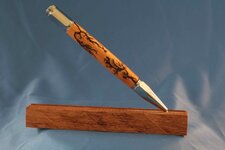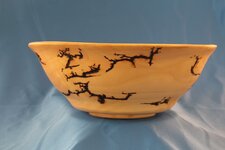You are using an out of date browser. It may not display this or other websites correctly.
You should upgrade or use an alternative browser.
You should upgrade or use an alternative browser.
Lichtenberg Pen
- Thread starter SkookumPens
- Start date
Signed-In Members Don't See This Ad
See more from SkookumPens
Yes, I forgot to mention that unit. It seems to work very well.
I just did a demo at a local club where I was one of three demonstrators. We showed a neon, two microwave and the Conestoga unit. It made for a very good demo....smoke & fire! The feedback was very positive!
I am a neon guy right now as it works for the turned items I want to burn.
The Conestoga Works Burner unit is 12,000V 35mA according th their website.
Pete, I believe the depth of the burn line depends on the burner. A microwave transformer will burn hotter, flame up, and scorch more around the burn, and burn deeper main lines. The shorter the burn time will help with depth not becoming too deep. The neon sign transformer and the Conestoga Works unit burn with less intensity. Like wise with an oil furnace transformer.
After burning, the piece is usually cleaned under running water with a nylon brush to remove the char and soot. After the piece is dry, light sanding can be done to settle down the raised grain.
At that point, any Finish may be applied as usual. An oil finish such as Tung oil finish or Danish Oil Finish or a spray lacquer can be used. With the burnt lines, CA or friction polishes are probably not the best choices.
If one sands the blank, raises the grain and resands before the burning, there will be less raised grain to deal with later.
Signed-In Members Don't See This Ad
Jim15
Member
Great looking pen.
mark james
IAP Collection, Curator
Very nice.
watch_art
Member
I'm planning on doing this with some of my pens... eventually. 
Charlie_W
Member
Super job on the pen!
I knew it was just a matter of time before someone else tried fractal burning on a pen!
Which transformer did you use? Neon, Microwave, or Oil Burner transformer?
I knew it was just a matter of time before someone else tried fractal burning on a pen!
Which transformer did you use? Neon, Microwave, or Oil Burner transformer?
SkookumPens
Member
I was nervous about building my own, so I bought mine from Conestoga Works. Carl Jacobson demonstrated it at our club meeting and I purchased it at the Oregon Symposium.
Charlie_W
Member
I was nervous about building my own, so I bought mine from Conestoga Works. Carl Jacobson demonstrated it at our club meeting and I purchased it at the Oregon Symposium.
Yes, I forgot to mention that unit. It seems to work very well.
I just did a demo at a local club where I was one of three demonstrators. We showed a neon, two microwave and the Conestoga unit. It made for a very good demo....smoke & fire! The feedback was very positive!
I am a neon guy right now as it works for the turned items I want to burn.
luckyscroller788
Member
This is something I'd love to do. Now I need to save up for one of those burners!
Ted iin Michigan
Member
Fascinating! Love the look!
Very cool! I played with this a few months ago and basically used the same process you did.... turn, burn, then glue and finish. I used an old oil burner transformed and was not too happy with the results. Since then I have gathered up a couple of different neon sign transformers and some high voltage wire but have not put it all together yet. That is on my short list of to do's and I think you have just moved it up a notch or two. Thanks buddy!
A few of questions ...
1. What is the output voltage and current of your transformer?
2. What did you use as an electrolyte (wetting solution)?
3. What type of wood did you use.
A word of caution to anyone following this thread. This process involves using transformers that produce VERY high voltages. There is information out there that will show you how this process is done. Some of it is good and some .... well, not so good. ALL of it is dangerous and CAN KILL YOU if you do not take proper precautions. If you are not familiar with electrical wiring AND how to handle high voltage, PLEASE, PLEASE either research and thoroughly educate yourself or leave this one alone.
A few of questions ...
1. What is the output voltage and current of your transformer?
2. What did you use as an electrolyte (wetting solution)?
3. What type of wood did you use.
A word of caution to anyone following this thread. This process involves using transformers that produce VERY high voltages. There is information out there that will show you how this process is done. Some of it is good and some .... well, not so good. ALL of it is dangerous and CAN KILL YOU if you do not take proper precautions. If you are not familiar with electrical wiring AND how to handle high voltage, PLEASE, PLEASE either research and thoroughly educate yourself or leave this one alone.
Charlie_W
Member
Very cool! I played with this a few months ago and basically used the same process you did.... turn, burn, then glue and finish. I used an old oil burner transformed and was not too happy with the results. Since then I have gathered up a couple of different neon sign transformers and some high voltage wire but have not put it all together yet. That is on my short list of to do's and I think you have just moved it up a notch or two. Thanks buddy!
A few of questions ...
1. What is the output voltage and current of your transformer?
2. What did you use as an electrolyte (wetting solution)?
3. What type of wood did you use.
A word of caution to anyone following this thread. This process involves using transformers that produce VERY high voltages. There is information out there that will show you how this process is done. Some of it is good and some .... well, not so good. ALL of it is dangerous and CAN KILL YOU if you do not take proper precautions. If you are not familiar with electrical wiring AND how to handle high voltage, PLEASE, PLEASE either research and thoroughly educate yourself or leave this one alone.
The Conestoga Works Burner unit is 12,000V 35mA according th their website.
SkookumPens
Member
Thanks for all the positive comments. I am still learning how to use the burner. Still trying to figure out how much solution to use.
I used a blank from a flowering cherry tree. It was recently cut down, so I nuked it until it was stable. I used a baking soda solution as an electrolyte. I was told that baking soda would turn cherry red. It did not seem to change the color. I plan to try salt on the next ones.
I agree with your warning. Carl Jacobson said several people were killed because of carelessness with either the problems with their burner or lack of appropriate safety procedures. I like the "Dead man" switch the Conestoga kit has.
Craig Chatterton
Puyallup, WA
I used a blank from a flowering cherry tree. It was recently cut down, so I nuked it until it was stable. I used a baking soda solution as an electrolyte. I was told that baking soda would turn cherry red. It did not seem to change the color. I plan to try salt on the next ones.
I agree with your warning. Carl Jacobson said several people were killed because of carelessness with either the problems with their burner or lack of appropriate safety procedures. I like the "Dead man" switch the Conestoga kit has.
Craig Chatterton
Puyallup, WA
Charlie_W
Member
I have been using the baking soda/water solution. I find it darkens some woods and on some oak, it turned some of the end grain a greenish color. I think the baking soda reacts with the tannins in the wood.
Another solution is borax/water as in laundry detergent borax. I have some but have not tried it yet. A burning friend reports that the borax does not darken the the the wood and sometimes even lightens the wood.
I have seen where some folks are using a wood bleach solution after the burning has been wash up and will purposely lighten the wood for a different effect.
One tip is to stir your baking soda/borax into hot water so it will dissolve and not just settle to the bottom.
Burn Smart....Burn Safe
Another solution is borax/water as in laundry detergent borax. I have some but have not tried it yet. A burning friend reports that the borax does not darken the the the wood and sometimes even lightens the wood.
I have seen where some folks are using a wood bleach solution after the burning has been wash up and will purposely lighten the wood for a different effect.
One tip is to stir your baking soda/borax into hot water so it will dissolve and not just settle to the bottom.
Burn Smart....Burn Safe
Jim Smith
Member
I've been think of trying this for a while, but the high voltage required to do this "etching" seems a bit too risky to me. That said, I think you could easily sell these blanks here on IAP to those of us not wanting to invest or take the chance of working with a Lichtenberg Figure Wood Burner. Just a thought...
Jim Smith
Jim Smith
Curly
Member
Gentlemen I'm curious. How deep does the wood get burnt? Is it deep enough to sand afterwards? Once burnt does it have to be left alone or finished? Thanks.
Charlie_W
Member
Gentlemen I'm curious. How deep does the wood get burnt? Is it deep enough to sand afterwards? Once burnt does it have to be left alone or finished? Thanks.
Pete, I believe the depth of the burn line depends on the burner. A microwave transformer will burn hotter, flame up, and scorch more around the burn, and burn deeper main lines. The shorter the burn time will help with depth not becoming too deep. The neon sign transformer and the Conestoga Works unit burn with less intensity. Like wise with an oil furnace transformer.
After burning, the piece is usually cleaned under running water with a nylon brush to remove the char and soot. After the piece is dry, light sanding can be done to settle down the raised grain.
At that point, any Finish may be applied as usual. An oil finish such as Tung oil finish or Danish Oil Finish or a spray lacquer can be used. With the burnt lines, CA or friction polishes are probably not the best choices.
If one sands the blank, raises the grain and resands before the burning, there will be less raised grain to deal with later.
SkookumPens
Member
I used a CA finish because that is my standard finish. I did not notice any problem. But, I am still playing around with it.
Craig Chatterton
Puyallup,WA
Craig Chatterton
Puyallup,WA
SkookumPens
Member
jttheclockman
Member
Can not be said enough. This goes right to the top of the list along with chemical burning and mixing to make some pen blanks. If you are going to do this please do your homework and take all safety precautions. This process can kill. Then you make no more pen blanks. There are no shortcuts here. There is no skipping the reading instructions here. As an electrician I would not even attempt this. Just bumping up the warning of this procedure. 
acmaclaren
Angi the Maker
Looks really cool!


